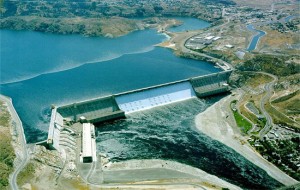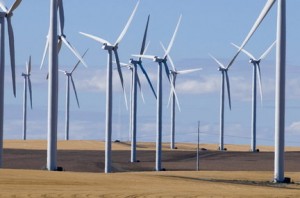
![]() Tweet To paraphrase Bob Dylan,”The answer my friend, is storage of the wind.”
Tweet To paraphrase Bob Dylan,”The answer my friend, is storage of the wind.”
We have long been saying that the question is not:
“Can clean, renewable and sustainable energy power the grid?”
It is:
“How can we harness clean, renewable and sustainable energy systems to power the grid?”
As Matt Wald observed in Taming Unruly Wind Power, shattering the conventional wisdom, the critique of renewable-resource energy is that it’s “not enough;” turns out to be wrong. In some places on some days, it’s not only enough, it more than we need. When the winds blow and the rains fall, a power grid built on wind and big hydro turbines, i.e. the northwest grid built on the Grand Coulee Dam, pictured at left, and the wind farms in the Columbia Gorge, below left, can get overloaded. So while you can never, according to the conventional wisdom, be too thin or too rich, you can have too much energy.
The corresponding criticism, that wind and solar don’t work in a storm, also applies to nuclear power.  As noted here, on Popular Logistics by Lawrence J. Furman, eight nuclear plants from North Carolina to Connecticut were shut down due to Hurricane Irene or the earthquake that preceded it. Wind and solar, however, unlike nuclear, come on automatically after the storm.
As noted here, on Popular Logistics by Lawrence J. Furman, eight nuclear plants from North Carolina to Connecticut were shut down due to Hurricane Irene or the earthquake that preceded it. Wind and solar, however, unlike nuclear, come on automatically after the storm.
Excerpted from Matthew L. Wald: Taming Unruly Wind Power, published in the New York Times, on November 5th, 2011
For decades, electric companies have swung into emergency mode when demand soars on blistering hot days, appealing to households to use less power. But with the rise of wind energy, utilities in the Pacific Northwest are sometimes dealing with the opposite: moments when there is too much electricity for the grid to soak up.
In June 2010, for example, a violent storm in the Northwest caused a simultaneous surge in wind power and in traditional hydropower, creating an oversupply that threatened to overwhelm the grid and cause a blackout. As a result, the Bonneville Power Administration, the wholesale supplier to a broad swath of the region, turned this year to a strategy common to regions with hot summers: adjusting volunteers’ home appliances by remote control to balance supply and demand. When excess supply threatens Bonneville’s grid, an operator in a control room hundreds of miles away will now dial up a volunteer’s water heater, raising the thermostat by 60 more degrees. Ceramic bricks in a nearby electric space heater can be warmed to hundreds of degrees. The devices then function as thermal batteries, capable of giving back the energy when it is needed. Microchips run both systems, ensuring that tap-water and room temperatures in the home hardly vary.
“It’s a little bit of that Big Brother control, almost,” said Theresa Rothweiler, a teacher’s aide in the Port Angeles, Wash., school system who nonetheless signed up for the program with her husband, Bruce, a teacher. She said she had been intrigued by an ad that Bonneville placed in the local paper that asked consumers to help enable the grid to absorb more renewable energy, especially wind. “We’re always looking at ways to save energy, or be more efficient or green, however you want to put it,” said Ms. Rothweiler, who worries about leaving the planet a livable place for her 21-year-old daughter, Gretchen. Bonneville paid for the special technology, which runs around $1,000 per home. The initial goal of Bonneville’s pilot program is to gain experience in charging and “discharging” the water heaters and space heaters to see how much response operators can count on as the use of these thermal batteries expands.
Mark K. Lauby, director of reliability assessment at the North American Electric Reliability Corporation, which enforces standards on the grid, said that such storage innovations would be “the holy grail” as the nation shifts to greater reliance on renewable energy. While the threat of excess supply is most severe in the Pacific Northwest, other regions may land in the same situation in coming years because a surplus would threaten to destabilize the electric system as much as a shortage. California, for example, is committed to getting a third of its electricity from renewable sources by 2020. That would be harder if it had to turn off the wind machines on their best generating days to prevent the grid from being overwhelmed.
For decades, the Bonneville Power Administration rarely had a problem with excess supply. Its backbone is hydroelectric dams on the Columbia River, and while the operators must often run all of the falling water through its power-producing turbines for environmental reasons, the grid could adjust the supply by turning off fossil fuel plants. That balance began to shift over the last few years as entrepreneurs built hundreds of wind machines nearby in the Columbia River Gorge, an area that utility executives now call a “wind ghetto.” While the wind turbines produce electricity far below their capacity most hours of the year, they get busy when a storm rolls through, which is when river flows are highest, too.